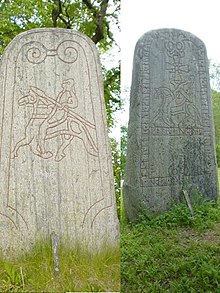Hornhausen equestrian stone

The Reiterstein von Hornhausen or Hornhäuser Reiterstein is a stone slab with a pictorial representation of a rider, which is dated to the 7th century. The original is in the possession of the State Office for Monument Preservation and Archeology Saxony-Anhalt in Halle (Saale) , a copy was embedded in the south wall of the tower of the Hornhausen St. Stephen's Church. The rider stone is said to be the remains of a choir screen of an early medieval church building. This representation is controversial. Since the equestrian stone points to the north Germanic area in terms of style and motifs, the conclusion is allowed to see the tombstone of a Saxon who was settled by the Franks in 531 in northern Thuringia between Bode and Ohre.
As silhouette stylized representation of the horn houses rider is the State Office for Heritage and Archeology as a logo. The district of Börde , founded on July 1, 2007 , also chose the Hornhausen rider as its coat of arms.
discovery
The Reiterstein von Hornhausen was found in 1874 while plowing a piece of arable land near the village. The finders of the stone slab, the farmers Friedrich and Christoph Dietrich, used the stone as an entrance slab to their cowshed. The professional world did not find out about this picture stone until 1912, and the Halle Museum began systematic excavations in 1913 . In the course of this, a total of 63 graves were discovered between 1923 and 1925. From 2013, more graves were found.
description
The stone probably represents a Frankish warrior of the 7th century. The rider with helmet, shield, sword and winged lance is shown in the middle field . Below is a meandering snake over which the horse strides. Two intertwined animals are shown below. There is a horizontal braided band above the rider , as is shown above all in Gotland picture stones .
The stone as an equestrian representation has parallels to the much older rune stones from Möjbro , one of the rune stones from Ålum Kirke , the rune stone U 855 from " Balingsta prästgård " and the rune stone from Skokloster in Uppland, Sweden (see picture). But while the Thuringian rider wears a shield with a vortex wheel representation (which is actually typical for the north), the Uppland rider has no shield at all and the older one an undecorated shield.
The equestrian stone from Hornhausen is said to have been part of an altar barrier , but the depicted warrior crossing the well-documented Vodan or pagan double-snake cipher stands in the tradition of a pictorial motif, as it is on the rune stones from Skokloster and Möbro in Uppland, Sweden, and in Danish Gold bracteates (e.g. Nær Køge-C ) occur, as well as on pressed sheet decorative images of spectacle helmets from the Vendel period (650–800 AD). According to early Christian custom, it is impossible for purely pagan motifs to find their place in front of the altar. There was often room for this in the tympanum and sometimes in the font reliefs to demonstrate to the person to be baptized whom he had to renounce.
Use as a coat of arms
The district of Börde uses this equestrian stone in its coat of arms. The von Rockhausen family has a coat of arms, the motif of which corresponds to the rider's shield and therefore suspects an early Franconian ancestor in this. Also in the coat of arms of Adenstedt in the district of Peine - slightly modified - the rider of Hornhausen has been in the shield since 1954. There he stands for the Germanic father of gods Wotan, or Odin , who plays a role in an old legend of Adenstedt. The legend relates to the barrows in Adenstedter Lah.
literature
- Hermann Ament : Hornhausen. In: Reallexikon der Germanischen Altertumskunde (RGA). 2nd Edition. Volume 15, Walter de Gruyter, Berlin / New York 2000, ISBN 3-11-016649-6 , p. 130 ( available for a fee from GAO , De Gruyter Online)
- Erik Nylén , Jan Peder Lamm: Picture stones on Gotland. Wachholtz, Neumünster 1981, 1991 (2nd edition), ISBN 3-529-01823-6 .
- R. Schwarz: The warrior's last ride to Valhalla In: State Museum for Prehistory (Hrsg.): Beauty, power and death. 2002, ISBN 3-910010-64-4 , p. 58.
- Wolfgang Schwarz : Hornhausen, Ldkr. Bördekreis. In: Siegfried Fröhlich (Ed.): From the prehistory of Saxony-Anhalt. State Museum for Prehistory Halle (Saale), Halle (Saale) 1995, ISBN 3-910010-13-X , No. 36.
- Reinhold Andert : The equestrian stone of Hornhausen. In: The Franconian Rider. Dingsda-Verlag Querfurt, Leipzig 2006, ISBN 3-928498-92-4 .
- Ernst Rieger, Artur Rockhausen, Johannes Webers: The Rockhausen family. Self-published, 1995.
Web links
Remarks
- ↑ Hornhausen in the Early Middle Ages at agisa.de, accessed on July 11, 2015
- ↑ R. Schwarz: The warrior's last ride to Walhall In. In: State Museum for Prehistory (ed.): Beauty, power and death. 120 finds from 120 years of the State Museum for Prehistory in Halle. State Office for Archeology, Halle (Saale) 2001. ISBN 3-910010-64-4 , p. 58
- ^ Article of July 18, 2007 in the Volksstimme Magdeburg.
- ^ Arnold Rabbow: New Braunschweigisches Wappenbuch, Braunschweig 2003, p. 144.


